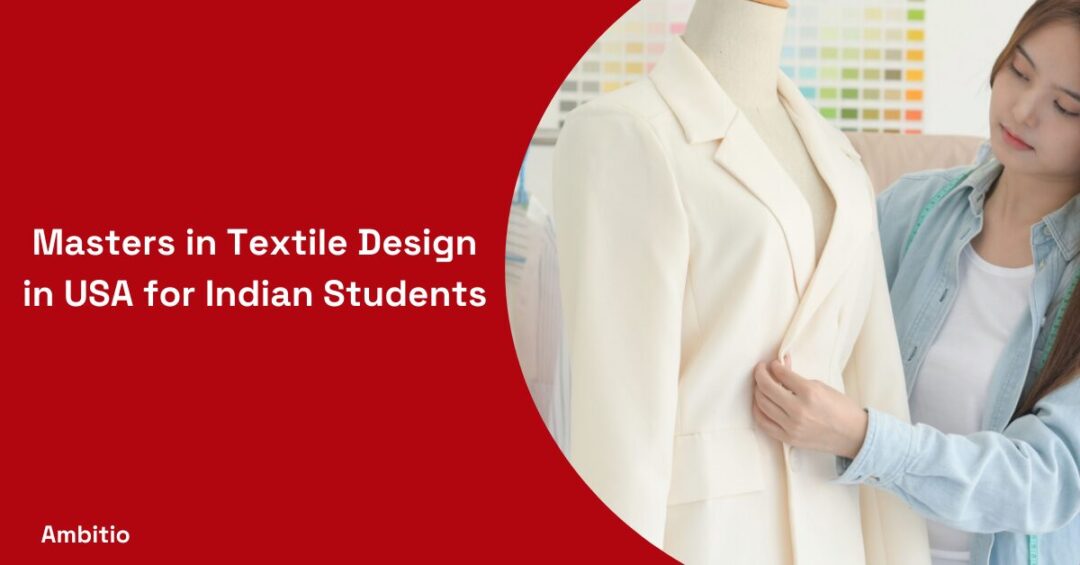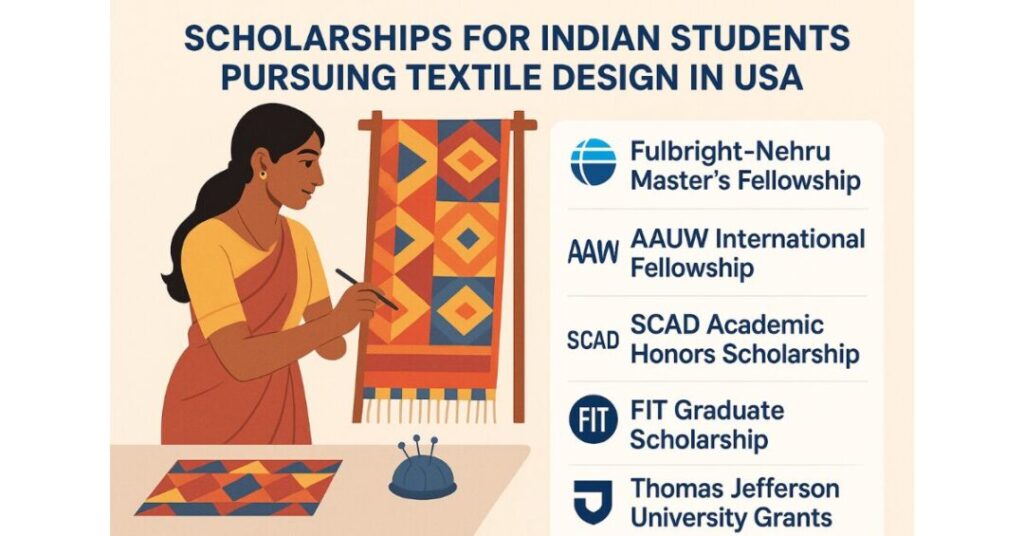19 September 2025
5 minutes read
Masters in Textile Design in USA for Indian Students

Key Takeaways
- Masters in textile design in USA gives Indian students global exposure, updated skills, and access to a $1.7 trillion fashion industry.
- Top universities offer innovative programs blending art, fashion, sustainability, and technology, with tuition ranging from $20,000–$45,000.
- Strong portfolios, meeting entry requirements, and securing scholarships make studying abroad achievable and rewarding.
Did you know the global textile and fashion industry is worth over $1.7 trillion, yet most Indian students struggle to break into it without the right degree? Talent alone doesn’t guarantee success; lack of exposure, outdated learning, and limited networking often hold students back.
That’s where pursuing masters in textile design in USA becomes a game-changer. With top universities, innovative courses, and global industry links, it equips you with professional skills to thrive in 2025 and beyond.
Why Pursue a Masters in Textile Design in USA?
Pursuing a masters in textile design in USA offers Indian students access to globally ranked universities, cutting-edge textile design courses, and real-world classroom experience. From Michigan University to Thomas Jefferson University, institutions offering master programs combine art, fashion, and technology with sustainability and innovation.
These degrees in textile and fashion design prepare graduates for careers in apparel, merchandising, interior, and brand management. With cross-border study, international exposure, and guidance from active members of the textile field, students emerge as globally competitive professionals.
Top Universities Offering Masters in Textile Design in USA
Choosing the right university for a masters in textile design in USA can feel overwhelming, especially for international students who want to study abroad.
From state universities to specialized design schools, the USA offers some of the best master degrees in fashion and textile design, combining craft, fabric innovation, and sustainability with global exposure.
| University | Program Offered | Average Tuition Fees (per year) | Highlights |
|---|---|---|---|
| Thomas Jefferson University | MS in Textile Design Program | $23,000 – $25,000 | Focus on knit, weave, fabric technology; taught by active members of the textile design field |
| University of Alabama | MS in Fashion and Textile Design | $20,000 – $22,000 | Wide variety of textile design courses, strong research background |
| University of Missouri | MS in Textile & Apparel Management | $22,000 – $24,000 | Known for sustainability, merchandising, and collaboration opportunities |
| Michigan State University | MS in Textile and Fashion Design | $24,000 – $26,000 | Combines art, technology, and design; excellent career flexibility |
| Washington State University | MS in Apparel, Merchandising, Design & Textiles | $21,000 – $23,000 | Innovative coursework, cross-border study options |
| University of North Carolina (Carolina) | MS in Fashion and Textile Design | $23,000 – $25,000 | Strong emphasis on aesthetic, knitwear, and design directors’ mentorship |
| Savannah College of Art and Design (SCAD) | MFA in Fashion & Textile Design | $38,000 – $40,000 | Globally ranked, cutting-edge design courses in the USA |
| Parsons School of Design | MFA in Fashion and Textile Design | $45,000 – $47,000 | Leading destination abroad for design directors and fashion researchers |
| Rhode Island School of Design (RISD) | MFA in Textiles | $42,000 – $44,000 | Fine arts in textiles, flexibility in subject areas, boundary-pushing craft |
| Fashion Institute of Technology (FIT), SUNY | MA/MFA in Textile and Fashion Design | $18,000 – $20,000 (in-state) | Affordable state university option with real-world classroom experience |
Eligibility Criteria and Admission Process for Masters Programs in Textile Design for Indian Students
Pursuing a masters in textile design in USA for 2024 requires careful preparation, as universities in the USA offering these programs have specific qualification standards and admission steps.

Indian students aiming to obtain a masters must refine their applications to meet the latest entry requirements and stand out as the best match.
Eligibility Criteria
- Academic Qualification
A bachelor’s degree in fashion, textiles, fine arts, or related fields is required. Universities assess prior coursework and your knowledge of textile design degrees and courses. - English Language Proficiency
IELTS or TOEFL scores are mandatory, with some institutions accepting Duolingo. This ensures you can collaborate effectively and adapt to an international classroom boundary. - Portfolio Requirement
Most programs require a strong portfolio showcasing fabric work, graphic design, knit, weave, or sustainable textile craft. This helps prove your potential as a designer. - Work Experience (Optional)
Though not always mandatory, relevant experience in retail, brand management, or textile design field adds weight. Some universities allow part-time professionals to apply.
Admission Process
- Application Submission
Apply online through the universities in the USA offering textile design degrees and courses. Contact schools directly to clarify program details and filter your results. - Supporting Documents
Submit transcripts, Statement of Purpose (SOP), Letters of Recommendation (LORs), and a refined portfolio. This array of documents helps universities assess your suitability. - Interviews and Reviews
Some institutions conduct interviews or portfolio reviews. Here, active members of the textile faculty evaluate your skills, creativity, and sustainable design mindset. - Final Admission Decision
Admission offers are based on qualification, portfolio, and overall application strength. Once accepted, you can obtain a masters and start exploring innovative, real-world classroom experiences in the USA.
Cost of Studying Masters Degree in Textile Design in USA
Pursuing a masters in textile design in USA requires financial planning, as tuition fees and living expenses vary across universities and locations. Understanding these costs helps students prepare better for study abroad.
| Expense Category | Average Annual Cost (USD) | Notes |
|---|---|---|
| Tuition Fees | $20,000 – $45,000 | Depends on university and program type |
| Living Expenses | $12,000 – $18,000 | Includes housing, food, and utilities |
| Health Insurance | $1,000 – $2,000 | Mandatory for international students |
| Books & Materials | $800 – $1,500 | Covers fabric samples, software, and supplies |
| Transportation | $700 – $1,200 | Varies by city and lifestyle |
| Miscellaneous Expenses | $1,000 – $2,000 | Personal and leisure costs |
Scholarships for Indian Students Pursuing Textile Design in USA
Financing a masters in textile design in USA can be challenging, but scholarships help reduce the financial burden.

Many universities and external bodies offer support for Indian students based on merit, need, or research potential.
| Scholarship Name | Offered By | Coverage | Eligibility Criteria |
|---|---|---|---|
| Fulbright-Nehru Master’s Fellowship | USIEF / Government of USA | Tuition, living, and airfare | Indian graduates with strong academics and leadership |
| AAUW International Fellowship | American Association of University Women | $20,000 – $25,000 | Women pursuing graduate studies in the USA |
| SCAD Academic Honors Scholarship | Savannah College of Art & Design | Partial tuition fee waiver | Based on GPA and portfolio strength |
| FIT Graduate Scholarship | Fashion Institute of Technology | Partial tuition fee waiver | Exceptional portfolio and academic record |
| Thomas Jefferson University Grants | Thomas Jefferson University | Up to 50% tuition waiver | Merit-based, renewable each year |
Conclusion
Pursuing a masters in textile design in USA is more than earning a degree; it’s about gaining global exposure, refining creativity, and shaping a future as an innovative designer. But standing out in competitive admissions requires more than good grades; it demands a strong profile, a compelling portfolio, and strategic guidance.
That’s where Ambitio comes in. As India’s leading study abroad consultancy specializing in profile building, we don’t just advise; we collaborate with you to craft success.
Ready to turn your design dreams into reality? Let’s build your future together with Ambitio Elite, your best match for global opportunities.
FAQs
What are the admission requirements for a Master’s in Textile Design in the USA?
Most universities require a bachelor’s degree in a related field, a portfolio of work, letters of recommendation, and proof of English proficiency for international students.
Can international students apply for financial aid in textile design programs?
Yes, many universities offer scholarships and financial aid options for international students. It’s advisable to check with the specific university for available opportunities.
How long does it typically take to complete a Master’s in Textile Design?
Most programs take 1 to 2 years to complete, depending on the university and whether the student is enrolled full-time or part-time.
What career opportunities are available after completing a Master’s in Textile Design?
Graduates can pursue careers as fashion designers, textile researchers, brand managers, sustainable textile consultants, or design directors in various industry sectors.
Do textile design programs in the USA include practical training?
Yes, programs typically include hands-on studio work, industry internships, and collaborative projects to integrate theoretical knowledge with practical skills.
Which universities are best for Textile Design in the USA?
Top universities include Rhode Island School of Design, North Carolina State University, and Pratt Institute, among others.
What should be included in my portfolio for a Textile Design program?
Your portfolio should showcase your creativity, technical skills, and any work related to textile techniques like knitting, weaving, or print design.

You can study at top universities worldwide!
Get expert tips and tricks to get into top universities with a free expert session.
Book Your Free 30-Minute Session Now! Book a call now




























